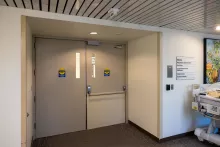Zephyr Valve (Bronchoscopic Lung Volume Reduction)
- For all other requests:
- 1-800-777-8442
If your COPD is caused by severe emphysema, a new treatment may help you breathe easier again.
Zephyr valves are placed in your damaged lung with a minimally invasive procedure. They let trapped air out of the most diseased part of the lungs. This allows the healthier part of your lungs to function better.
University of Iowa Health Care pulmonologists were involved in early studies for this innovative treatment. This means they have special expertise and years of experience. In fact, they’re currently the only ones in the state using Zephyr valves.
If you’re eligible for Zephyr valves, they can help improve your quality of life. They can help you breathe easier, have more energy, and get back to the activities you love.
How Zephyr valves work
Zephyr valves are one-way valves that interventional pulmonologists can place into the diseased part of your lung. The valves can help you to breathe easier and reduce the amount of air trapped in your lungs.
Emphysema causes damage to lung tissue over time. The tiny, stretchy air sacs (alveoli) in your lungs lose their elasticity and become floppy. This causes two problems:
Air trapping: When you exhale, stale air stays trapped in your lungs, leaving limited room for new, oxygen-rich air to enter.
Hyperinflation: When you can’t fully exhale, your lungs stay overinflated. This puts pressure on your diaphragm, the large muscle that contracts when you inhale and relaxes when you exhale. The pressure keeps you from being able to take deep breaths.
Evaluation and preparation for Zephyr valve placement takes several months.
If you smoke, you must be smoke-free for at least four months before you have the procedure. UI Health Care smoking cessation specialists can help you quit.
You should plan to complete a pulmonary rehabilitation program before you have valves placed. This will help you build stamina and strength so you’re as healthy as possible for your procedure. This will also help you achieve the most benefit.
Your pulmonologist will talk with you and answer all your questions before your procedure.
The procedure is done under general anesthesia. It typically takes one to two hours.
After the procedure, you’ll be admitted into the hospital for monitoring.
There is a possibility that your pulmonologist may not place the valves after further assessment during the bronchoscopy.
You will stay in the hospital for at least three nights to monitor for complications. The day after your procedure, you’ll be up and walking several times a day.
Some people experience a small tear in the lung tissue during the procedure. If this happens, your pulmonologist will place a small tube in your chest to let the air out.
You’ll continue using your emphysema medication after the valves are placed. If you currently use supplemental oxygen, you will continue to use it.
After you’re discharged, you’ll ease back into your regular activities. In one to two weeks, you’ll go back to pulmonary rehabilitation.
Ten days after your procedure, you’ll see your pulmonologist for a follow-up appointment.
Are you a candidate for Zephyr valves?
Your care team will do a thorough assessment to make sure that Zephyr valves will work for you.
You’ll have a series of tests to determine whether you’re a good candidate, including:
- Pulmonary function testing
- CT scan of your lungs
- Echocardiogram
- Arterial blood gas test to measure the levels of oxygen and carbon dioxide in your blood
- Six-minute walk test
- A questionnaire about your limitations and quality of life
Depending on your results, your pulmonologist may also order additional tests, including:
- Electrocardiogram (EKG) to check for heart problems
- Perfusion scan to assess blood flow to different parts of the lung
To benefit from Zephyr valves, you must be willing to commit to:
- Quitting smoking for at least four months before you have the procedure, and not smoking afterward
- A pulmonary rehabilitation program before and after the procedure
A bridge to lung transplant
If you’re on the waiting list for a lung transplant, the Zephyr valve procedure could potentially help while you wait. Having Zephyr valves placed doesn’t change your eligibility for lung transplant.
Who isn’t eligible for the Zephyr valve procedure?
The Zephyr valve procedure might not be right for you if:
- You’re not physically able to have a bronchoscopic procedure
- You have an active lung infection
- You’re allergic to nickel, titanium, nitinol, or silicone
- You still smoke
- You have an air pocket (bulla) that’s larger than one-third the size of your lung
- You have holes in the tissue separating the lobes of your lungs (collateral ventilation). This means air can move from one lobe to the other, so valves would not be effective.
If you’re not eligible for Zephyr valves
If you don’t meet the criteria for having Zephyr valves placed, UI Health Care pulmonologists can offer you options, including:
- Help to quit smoking
- Medication to help your airways relax
- Pulmonary rehabilitation to teach you effective breathing techniques and help you get stronger with the right kind of exercise
- Long-term oxygen therapy
- Evaluation by a thoracic surgeon to see if a surgical procedure could help
- Evaluation for lung transplant
Our Care Team






Wondering whether the Zephyr valve procedure is right for you?
Locations and Offices

